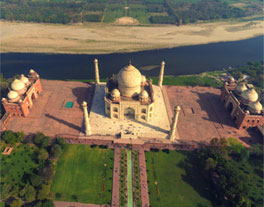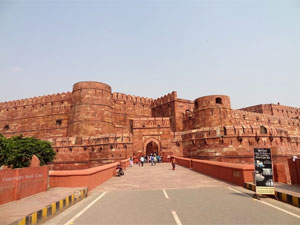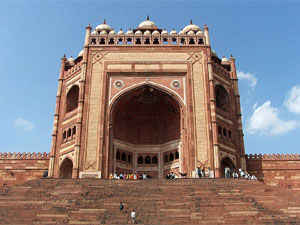It's the city of Agra that has received the honor of having one of Seven Wonders of the World, the Taj Mahal: an abode for eternal Love, in its courtyard. Located in the northern state of Uttar Pradesh, India, Agra has been one powerful city since the medieval times. The city finds mention in the epic Mahabharata and later gained recognition as the capital of Mughal Empire from 1526 to 1658 under the emperors Akbar, Jahangir, and Shah Jahan. At that time, the city of Agra was also known as Akbarabad. Till date, it remains a major tourist destination, courtesy three of the most famous Mughal era buildings like Agra Fort, Fatehpur Sikri, and most notably the terrific Taj Mahal, all three of which stand as the UNESCO World Heritage Sites. The Taj Mahal in particular, built by Shah Jahan in the memory of his beloved wife Mumtaz Mahal, is one of the most recognizable buildings in the world and is visited by millions of tourists annually.
The location for Taj Mahal was clearly a well thought out decision by Shah Jahan who chose a peaceful site about one and a half miles away from Agra at the southern edge of the city at the banks of river Yamuna. This location also had a strategic importance for the emperor, as it could be seen from his palace in the Agra Fort. The closeness to the river Yamuna not only gave this location a scenic edge, but also met the need for water during construction purposes and laying out the garden. Moving on to the Taj, the entire complex consists of a number of buildings comprising of a mosque, a guesthouse and the mausoleum, housing both the tombs of Mumtaz Mahal and Shah Jahan. A long and beautiful walkway leads to the main mausoleum, which is built of pure white marble. Four waterways divide the gardens that stand in front of the Taj into four parts and then, meet in a pool at the center. It is believed that half of the beauty of Taj Mahal comes from this strategic location where it stands.
With Taj Mahal being in the premises of the Agra city and the city itself being the 19th most populous city of India, getting to it and the stupendous Taj Mahal isn't much of a problem. The Taj Mahal is located within 6 km of distance from the Agra city centre and is easily accessible by auto rickshaw or a cab. With the city being well connected by national highways, it is easily accessible through road from all major cities in India. The three railway stations: Agra Cantt, Agra Fort Railway station (from where the Taj is at 10-15 minutes of walking distance), and Raja ki Mandi connect almost all cities of the country and make access to the city of Taj an easy affair. For those who are extremely busy but still do not want to miss an opportunity to immerse themselves in the beauty of the Taj Mahal, getting to Agra by flight would be the easiest way out. Agra airport, which is around 6 km from the city centre, has Indian Airways' flights flying in and out on a daily basis.
Agra is the city of Taj Mahal, which makes it the most popular city of India. It is located near the River Yamuna on the northern state Uttar Pradesh of India, and is the most populated city of Uttah Pradesh with more than 1.5 million people.
In the famous epic Mahabharat, Agra was referred as the forest of Agraban, and the epic dates the foundation of the city to 1475 during the reign of Raja Badal Singh. However a Persian poet named Mas'ud Sa'd Salman mentions about Agra in the 11th century. The ancient fort of Agra, Badalgarh, from the reign of Raja Badal Singh should be somewhere near or on the present fort.
In 1506, Sultan Sikandar Lodi moved the capital from Delhi to Agra.
His son Ibrahim Lodi also used Agra as the capital until he was defeated by the Persian King Babur. Babur was the founder of the Mughal Empire and he sent his son Humayun to capture the city. Mughal empire not only captured Agra, but also the largest diamond of that time, Koh-i-Noor. Under the dominion of Mughals, Agra lived its heydays between 1526 and 1658 and it was called Akbarabad.
Muhgals were famous with their love of architecture, and the most of the fascinating buildings that one can see today belong to the Mughal period between 15th and 16th centuries including the three UNESCO World Heritages: Taj Mahal, Agra Fort and Fatehpur Sikri. Babur's grandson Akbar made Akbarabad the center of arts, culture and commerce and religion. He constructed many beautiful buildings including the city Fatehpur Sikri which was inspired by a Mughal military camp.
In the 17th century, Cihangir ( Jahangiri) made Akbarabad the hotspot of Muslim world. His son Sah Cihan (Shahjahan) ordered the Taj Mahal to be constructed in memory of his beloved wife Mumtaz Mahal. The mausoleum was completed in 1653. After that, Shah Jahan moved the capital back to Delhi and this made Agra lose its importance.
In the 17th century, Cihangir ( Jahangiri) made Akbarabad the hotspot of Muslim world. His son Sah Cihan (Shahjahan) ordered the Taj Mahal to be constructed in memory of his beloved wife Mumtaz Mahal. The mausoleum was completed in 1653. After that, Shah Jahan moved the capital back to Delhi and this made Agra lose its importance.

Taj Mahal was built by the grief stricken Emperor Shah Jahan as a memorial to his beloved wife Arjumand Bano Begum entitled as Mumtaz Mahal. This world renowned wonder sits pretty on the four sides. The Quranic inscriptins on its four entrances are carved in such subtle increase in size that words appear to be of the same size from top to bottom. Shah Jahan invited master craftsmen from places like Italy and Persia to help Design his ambitious tribute to love.
The Taj Mahal is phenomenal not in the beauty alone that sines foth, but in the deep planning and design that went into its making and the ethereal idea of immortalizing love. Delicate carving in marble vie with gorgeous pietra dura for attention. Lapislazuli, Cornelian,
Jasper, Malachite, Coral, Mother of Peral, Agate and Emerald are inlayed in floral and geometrical patterns in the marble itself. Constuction of this enchanting mausleum, on the bank of river yamuna started in 1631 AD and it is believed that it took about 22 years to complete the whole premises with help of an estimates 20000 workers. Visiting hours: Opens 30 minutes before Sunrise and closes 30 minutes before Sunset.
The great Mughal Emperor Akbar commissioned the construction of the Agra Fort in 1565 A.D., although additions were made till the time of his grandson Shah Jahan. The forbidding exteriors of this fort hight an inner pardise. The fort is crescent shaped, flattended on the east with a long, nearly straight wall facing the river. It has a total perimeter of 2.4 k.m., and is ringed by double castellated ramparts of red sandstone punctuated at regular intervals by bastions. A 9 mt. wide and 10 mt. deep moat surround the outer wall. There are number of exquisite building like the Moti Masjid-a white marvel mosque akin to a perfect pearl, Diwan-e-Am, Diwan-e-Khaas, Jehangir's Palace, Khaas Mahal, Shish Mahal and Musamman or Samman Burj-where Shahjahan was held captive in 1666 A.D.


Fatehpur Sikri is an epic in red sandstone. A city of yeasteryear, today lost in the mists of time. Fatehpur Sikri was built by the Mughal Emperor Akbar during 1564 A.D.. Mughal Emperor Akbar had no heir. He visited holy men to enlist their prayers for his son. When he visited Sheikh Salim Chishti who was living at the village of Sikri the saint foretold the emperor that he would be blessed with a son. When is son was born, he is gratitude, constructed his capital city and named it Fatehpur Sikri. Later, due to sortage of water and unrest in North-West, Akbar has to abandon this city. The beautiful marvel tomb of Sheikh Salim Chishti still attract thousands who seek blessings of the revered saint. Other renowned places are Dewane-e-Am, Dewane-e-Khaas, Buland Darwaja, Panch Mahal, Jodha Bai Palace and Birbal Bhawan. Fatehpur Sikri is about 39 K.M. from Agra.






